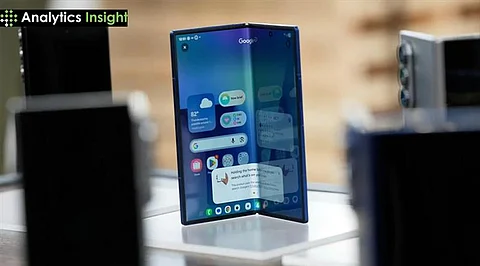

According to Canalys data, Samsung has gained substantially in the US smartphone market. In Q2 2025, Samsung's market share increased from 23% to 31%, while Apple's decreased from 56% to 49%. This transition is the first instance in more than a decade where Apple has experienced a loss in its leading status in the native market.
Samsung's transition to foldable smartphones is the main reason behind its recent success. The release of the Samsung Z Fold 7 and Z Flip has created a lot of hype, particularly on social media.
The increasing buzz has been created by viral videos that demonstrate these devices with durability tests. Samsung's foldables are innovative and similar in design, appealing to both technology enthusiasts and mainstream consumers.
Folded phones such as the Z Fold 7 and the Z Flip by Samsung are creating a new benchmark in the smartphone market. These models are not only reaching new thin hardware limits but also satisfying the increasing demand for innovative, practical design. The Z Fold 7 has a screen that expands into a tablet size, and the Z Flip, which folds vertically like a flip phone, is catching up.
The foldables have a viral quality, and Samsung's high-end phones are mentioned at least 50,000 times on networks such as Sprout Social. One of the most viral moments was a livestream that showed a Z Fold 7 folding more than 200,000 times, with millions of views on YouTube.
According to Drew Blackard, the Vice President of Mobile Product Management at Samsung Electronics America, the Samsung Z Fold 7 was selling 50% quicker than its predecessor and was preordered 25% more.
Samsung's marketing strategy, in terms of its pricing system, has also contributed to its success. The company serves a very diverse customer base with an extensive variety of smartphones to fit various price budgets.
Samsung provides a larger variety of products and caters to a broader audience with models priced from approximately $650 to premium devices like the Z Fold 7, priced up to $2,419.
By contrast, the iPhone line has limited products at prices starting at $829 and up to $1,599. Although the iPhone 16 Pro Max is the most costly model in Apple's range, Samsung, with its price flexibility, provides more opportunities to consumers.
Moreover, Samsung's worldwide sales are enjoying a ripple effect in the industry. Canalys analyst Runar Bjorhovde said that Samsung has succeeded in capturing customers at a wide range of prices, which has seen it increase its market share. Apple's current model range is relatively static and less flexible, with customers increasingly expecting variety and innovation.
Although Apple still reigns supreme in the rest of the world, it is playing catch-up in the foldable segment. Apple has not announced an iPhone with a foldable display, though a report by industry analysts suggests that the first foldable model will not be available until 2026.
This delay has given Samsung more opportunities to capitalize on capturing the market of foldable phones as it further consolidates its standing. Experts say that Apple tends to bide its time until a technology is mature enough to be adopted completely.
However, this cautious approach has already sparked concern among investors. Apple shares have fallen by 7.5% this year, but Samsung shares have rocketed by over 35%.
In spite of this, Apple is also dedicated to innovation, with some speculation of an even thinner iPhone Air and a second-generation Siri in 2026. But the question is, can Apple re-establish its competitiveness in the foldable and AI market?
Also Read: Samsung Galaxy Z Flip 7 Review: Is it Worth a Buy?
